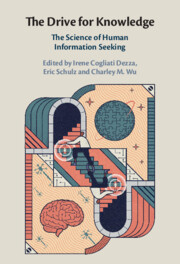Book contents
- The Drive for Knowledge
- The Drive for Knowledge
- Copyright page
- Contents
- Figures
- Tables
- Notes on Contributors
- Preface
- Part I What Drives Humans to Seek Information?
- Part II How Do Humans Search for Information?
- Chapter 5 What Makes a Good Query?
- Chapter 6 Active Inference, Bayesian Optimal Design, and Expected Utility
- Chapter 7 Exploration Beyond Bandits
- Chapter 8 Representational Exchange in Human Social Learning
- Part III Which Machinery Supports the Drive for Knowledge?
- Index
- References
Chapter 5 - What Makes a Good Query?
Prospects for a Comprehensive Theory of Human Information Acquisition
from Part II - How Do Humans Search for Information?
Published online by Cambridge University Press: 19 May 2022
- The Drive for Knowledge
- The Drive for Knowledge
- Copyright page
- Contents
- Figures
- Tables
- Notes on Contributors
- Preface
- Part I What Drives Humans to Seek Information?
- Part II How Do Humans Search for Information?
- Chapter 5 What Makes a Good Query?
- Chapter 6 Active Inference, Bayesian Optimal Design, and Expected Utility
- Chapter 7 Exploration Beyond Bandits
- Chapter 8 Representational Exchange in Human Social Learning
- Part III Which Machinery Supports the Drive for Knowledge?
- Index
- References
Summary
Searching for information in a goal-directed manner is central for learning, diagnosis, and prediction. Children ask questions to learn new concepts, doctors conduct medical tests to diagnose their patients, and scientists perform experiments to test their theories. But what makes a good query? What principles govern human information acquisition and how do people decide which query to conduct to achieve their goals? What challenges need to be met to advance the theory and psychology of human inquiry? Addressing these issues, we introduce the conceptual and mathematical ideas underlying different models of the value of information, what purpose these models serve in psychological research, and how they can be integrated in a unified computational framework. We also discuss the conflict between short- and long-term efficiency of prominent methods for query selection, and the resulting normative and methodological implications for studying human sequential search. A final point of discussion concerns the relations between probabilistic (Bayesian) models of the value of information and heuristic search strategies, and the insights that can be gained from bridging different levels of analysis and types of models. We conclude by discussing open questions and challenges that research needs to address to build a comprehensive theory of human information acquisition.
- Type
- Chapter
- Information
- The Drive for KnowledgeThe Science of Human Information Seeking, pp. 101 - 123Publisher: Cambridge University PressPrint publication year: 2022

